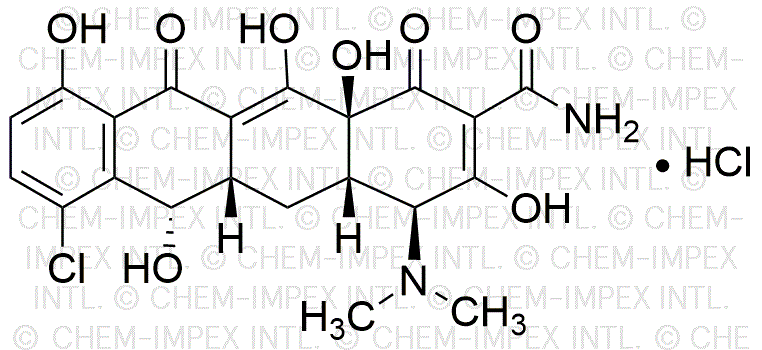Demeclocycline hydrochloride powder or crystals is widely utilized in research focused on:
- Antibiotic Development: It serves as a key compound in the development of new antibiotics, particularly for treating bacterial infections. Its unique structure allows researchers to modify it for enhanced efficacy against resistant strains.
- Clinical Research: This compound is often used in clinical trials to evaluate its effectiveness in treating various infections, providing valuable data for healthcare professionals and pharmaceutical companies.
- Veterinary Medicine: Demeclocycline is applied in veterinary settings to treat infections in animals, ensuring animal health and welfare, which is crucial for livestock and pets.
- Research on Tetracycline Derivatives: It is a valuable tool in studies aimed at understanding the mechanisms of action of tetracycline antibiotics, helping to inform the design of next-generation antibiotics.
- Biochemical Studies: The compound is used in biochemical research to investigate protein synthesis and cellular processes, aiding scientists in understanding fundamental biological mechanisms.
Informations générales
Propriétés
Sécurité et réglementation
Applications
Demeclocycline hydrochloride powder or crystals is widely utilized in research focused on:
- Antibiotic Development: It serves as a key compound in the development of new antibiotics, particularly for treating bacterial infections. Its unique structure allows researchers to modify it for enhanced efficacy against resistant strains.
- Clinical Research: This compound is often used in clinical trials to evaluate its effectiveness in treating various infections, providing valuable data for healthcare professionals and pharmaceutical companies.
- Veterinary Medicine: Demeclocycline is applied in veterinary settings to treat infections in animals, ensuring animal health and welfare, which is crucial for livestock and pets.
- Research on Tetracycline Derivatives: It is a valuable tool in studies aimed at understanding the mechanisms of action of tetracycline antibiotics, helping to inform the design of next-generation antibiotics.
- Biochemical Studies: The compound is used in biochemical research to investigate protein synthesis and cellular processes, aiding scientists in understanding fundamental biological mechanisms.
Documents
Fiches de données de sécurité (FDS)
La FDS fournit des informations de sécurité complètes sur la manipulation, le stockage et l’élimination du produit.
Spécifications du produit (PS)
Le PS fournit une description complète des propriétés du produit, notamment sa composition chimique, son état physique, sa pureté et les exigences de stockage. Il détaille également les plages de qualité acceptables et les applications prévues du produit.
Certificats d'analyse (COA)
Recherchez des certificats d'analyse (COA) en saisissant le numéro de lot du produit. Les numéros de lot et de lot se trouvent sur l'étiquette d'un produit, après les mots « Lot » ou « Lot de fabrication ».
Numéro de catalogue
Numéro de lot/série
Certificats d'origine (COO)
Ce certificat d'exploitation confirme le pays dans lequel le produit a été fabriqué, et détaille également les matériaux et composants utilisés et s'il est issu de sources naturelles, synthétiques ou autres sources spécifiques. Ce certificat peut être requis pour les douanes, le commerce et la conformité réglementaire.
Numéro de catalogue
Numéro de lot/série
Fiches de données de sécurité (FDS)
La FDS fournit des informations de sécurité complètes sur la manipulation, le stockage et l’élimination du produit.
DownloadSpécifications du produit (PS)
Le PS fournit une description complète des propriétés du produit, notamment sa composition chimique, son état physique, sa pureté et les exigences de stockage. Il détaille également les plages de qualité acceptables et les applications prévues du produit.
DownloadCertificats d'analyse (COA)
Recherchez des certificats d'analyse (COA) en saisissant le numéro de lot du produit. Les numéros de lot et de lot se trouvent sur l'étiquette d'un produit, après les mots « Lot » ou « Lot de fabrication ».
Numéro de catalogue
Numéro de lot/série
Certificats d'origine (COO)
Ce certificat d'exploitation confirme le pays dans lequel le produit a été fabriqué, et détaille également les matériaux et composants utilisés et s'il est issu de sources naturelles, synthétiques ou autres sources spécifiques. Ce certificat peut être requis pour les douanes, le commerce et la conformité réglementaire.


